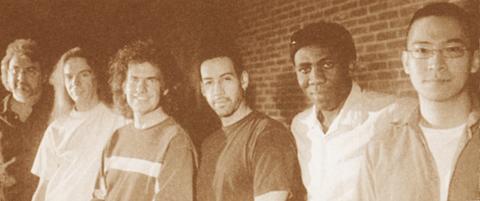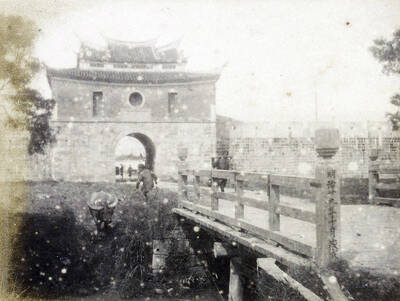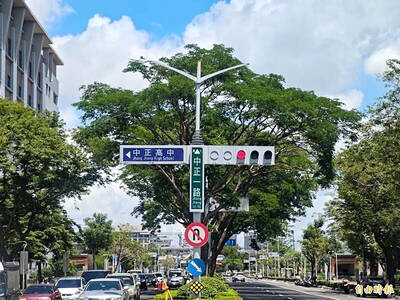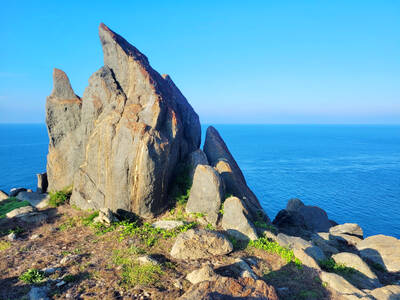Music aficionados rejoice! The Pat Metheny Group will unleash its creative brilliance in Taipei this weekend. The Group is in town for two nights -- Sunday and Monday -- as part of a world tour through Europe, Asia and finally North America.
They are currently tantalizing audiences on the tour with the group's eleventh album, Speaking of Now.

PHOTO COURTESY OF THE PAT METHENY GROUP
This new studio album has taken the group to a new level of musical artistry, a joyous new stride in their journey of discovery. With three exciting new faces in the band, Metheny and his long-time pianist/collaborator, Lyle Mays, join bassist and co-producer Steve Rodby (now in his 20th year with the band) to once again challenge the basic premise of what a modern-day jazz group can be, delivering a collection of music that delights and resonates with its unique musical perspective that speaks to listeners everywhere.
Featuring many of the tracks from Speaking of Now, the group will perform nearly three-hours of uninterrupted soulful interchange led by the man with the Einstein hairdo.
With over 20 years under his belt as a recording artist, guitarist Pat Metheny has generated dozens of albums, each one brilliantly documenting another aspect of his unique and nearly uncategorizable musical journey.
Metheny's versatility is almost without peer on any instrument. Over the years, he has performed with artists as diverse as Milton Nascimento to Charlie Haden, from Herbie Hancock to David Bowie. In addition, he has been part of a writing team with keyboardist Mays for more than 20 years -- an association that has been compared to the Lennon/McCartney partnership.
It is one thing to attain popularity as a musician, but it is another to receive the kind of acclaim Metheny has garnered from critics and peers. Over the years, Metheny has won countless polls as "Best Jazz Guitarist" and awards, including three gold records for Talking (Still Life), Letter from Home, and Secret Story. He has also won 14 Grammy Awards spread out over a variety of different categories including Best Rock Instrumental, Best Contemporary Jazz Recording, Best Jazz Instrumental Solo and Best Instrumental Composition. The road is nothing new to Metheny. He has spent most of his life on tour, averaging between 120 to 240 shows a year since 1974 and is well known for exhibiting an insatiable creative energy -- both in the studio and on stage -- that appears bent on blurring the stylistic boundaries at every opportunity.
Metheny first burst onto the international jazz scene in 1974. Over the course of his three-year stint with vibraphone great Gary Burton, the young Missouri native already displayed his soon-to-become trademarked playing style, which blended the loose and flexible articulation customarily reserved for horn players with an advanced rhythmic and harmonic sensibility -- a way of playing and improvising that was modern in conception but grounded deeply in the jazz tradition of melody, swing and the blues. With the release of his first album, Bright Size Life (1975), he reinvented the traditional jazz guitar sound for a new generation of players.
Throughout his career, Metheny has continued to re-define the genre by utilizing new technology and constantly working to evolve the improvisational and sonic potential of his instrument. With the 2002 tour, Metheny and cohorts have chosen to feature much of the new album within a framework that allows for individual highlights.
Metheny obviously recognizes the need for the group dynamic to elevate sterile studio recordings to the larger, more raucous stage before an audience. His choices also allow him the freedom to feature songs in certain formats: solo, duo, trio, and group dynamics.
The members of the group are, in their own right, highly accomplished artists themselves. Lyle Mays' sense of melody, crystal clear virtuosity and almost cinematic scope of orchestration has clearly distinguished the group's sound. Music has always been a large part of Mays' life. Born in 1953 into a musical family in Wausaukee, Wisconsin, he was always encouraged to explore new forms of expression. He then studied composition and arrangement at North Texas State University before touring with Woody Herman's Thundering Herd. While appearing at the 1975 Wichita Jazz Festival, Mays met 20-year-old guitarist, Pat Metheny. Mays moved to Boston in 1977, and the two formed a musical alliance that has proven to be among the most artistically successful of the past two decades. In addition to winning nine Grammy Awards with the Pat Metheny Group, Mays has been nominated four times for his own work.
Acoustic and electric bassist Steve Rodby was born in December 1954 in Joliet, Illinois. A graduate of Northwestern University with a degree in classical bass performance, Rodby studied with Warren Benfield (of the Chicago Symphony Orchestra) and the renowned jazz bassist, Rufus Reid. In addition to performing with the Pat Metheny Group for the past 22 years, Rodby has conducted orchestras, recorded with many other artists, and lately has spent much of his time producing.
Vocalist, multi-instrumentalist and composer Richard Bona, the newest addition to the Pat Metheny Group, has lived a life of adventure, ingenuity and accomplishment.
Born in 1967 in the village of Minta in East Cameroon, Richard grew up in a home filled with music. At age 22, he moved to Paris, enrolling in a music school to refine his writing skills and immersed himself in the work of such artists as Miles Davis, Chet Baker and Ben Webster.
In 1995 Bona moved to New York to subsequently become Harry Belafonte's bandleader and musical director for a year and a half. He has toured extensively with Sadao Watanabe as well as producing his latest album. He has also performed or recorded with the likes of Michael Brecker, Steve Gadd, Branford Marsalis and Bob James.
Considered to be one of the most distinctive stylists on New York's Downtown music scene, Cuong Vu has been garnering rave reviews as one of the leaders of a new generation of innovative musicians. Most recently he was mentioned as one of the top 50 young jazz artists in an article called The New Masters, from the British magazine, Classic CD. Cuong began playing the trumpet at the age of 11, five years after emigrating to Seattle, Washington from Vietnam. His intense dedication and love for music led him to a full scholarship at the New England Conservatory of Music where he received his Bachelor of Music in Jazz studies with a distinction in performance.
Since his arrival in New York, Cuong has toured internationally and in the states as well as performing and/or recorded with David Bowie, Laurie Anderson, Mitchell Froom and Cibo Matto.
Antonio Sanchez was born in Mexico City Nov. 1, 1971. At age five, he discovered an irresistible attraction towards the drumset. It wasn't long before he started studying privately with some of the best teachers that Mexico had to offer. After a few years he started performing in a wide variety of musical situations ranging from rock to jazz and latin to fusion with several bands in the city's music scene.
At age seventeen he enrolled in the National Conservatory of Music in Mexico City where he pursued a degree in classical piano and composition. In 1993, after four and a half years, he earned a scholarship to pursue Jazz Studies at Berklee College of Music in Boston, where he had the chance to study jazz arranging, improvisation, jazz composition, ear training and harmony among other music related courses. It was in Europe where Metheny started taking notice of Antonio's drumming and he was later offered the drum chair in The Pat Metheny Group.

June 9 to June 15 A photo of two men riding trendy high-wheel Penny-Farthing bicycles past a Qing Dynasty gate aptly captures the essence of Taipei in 1897 — a newly colonized city on the cusp of great change. The Japanese began making significant modifications to the cityscape in 1899, tearing down Qing-era structures, widening boulevards and installing Western-style infrastructure and buildings. The photographer, Minosuke Imamura, only spent a year in Taiwan as a cartographer for the governor-general’s office, but he left behind a treasure trove of 130 images showing life at the onset of Japanese rule, spanning July 1897 to

One of the most important gripes that Taiwanese have about the Democratic Progressive Party (DPP) is that it has failed to deliver concretely on higher wages, housing prices and other bread-and-butter issues. The parallel complaint is that the DPP cares only about glamor issues, such as removing markers of Chinese Nationalist Party (KMT) colonialism by renaming them, or what the KMT codes as “de-Sinification.” Once again, as a critical election looms, the DPP is presenting evidence for that charge. The KMT was quick to jump on the recent proposal of the Ministry of the Interior (MOI) to rename roads that symbolize

On the evening of June 1, Control Yuan Secretary-General Lee Chun-yi (李俊俋) apologized and resigned in disgrace. His crime was instructing his driver to use a Control Yuan vehicle to transport his dog to a pet grooming salon. The Control Yuan is the government branch that investigates, audits and impeaches government officials for, among other things, misuse of government funds, so his misuse of a government vehicle was highly inappropriate. If this story were told to anyone living in the golden era of swaggering gangsters, flashy nouveau riche businessmen, and corrupt “black gold” politics of the 1980s and 1990s, they would have laughed.

It was just before 6am on a sunny November morning and I could hardly contain my excitement as I arrived at the wharf where I would catch the boat to one of Penghu’s most difficult-to-access islands, a trip that had been on my list for nearly a decade. Little did I know, my dream would soon be crushed. Unsure about which boat was heading to Huayu (花嶼), I found someone who appeared to be a local and asked if this was the right place to wait. “Oh, the boat to Huayu’s been canceled today,” she told me. I couldn’t believe my ears. Surely,